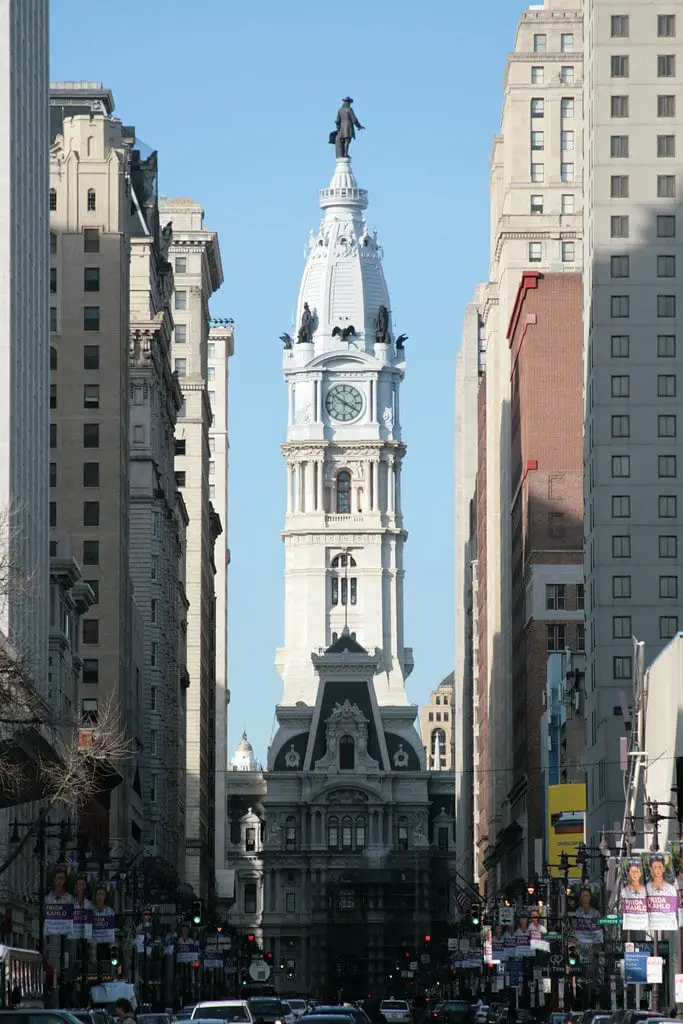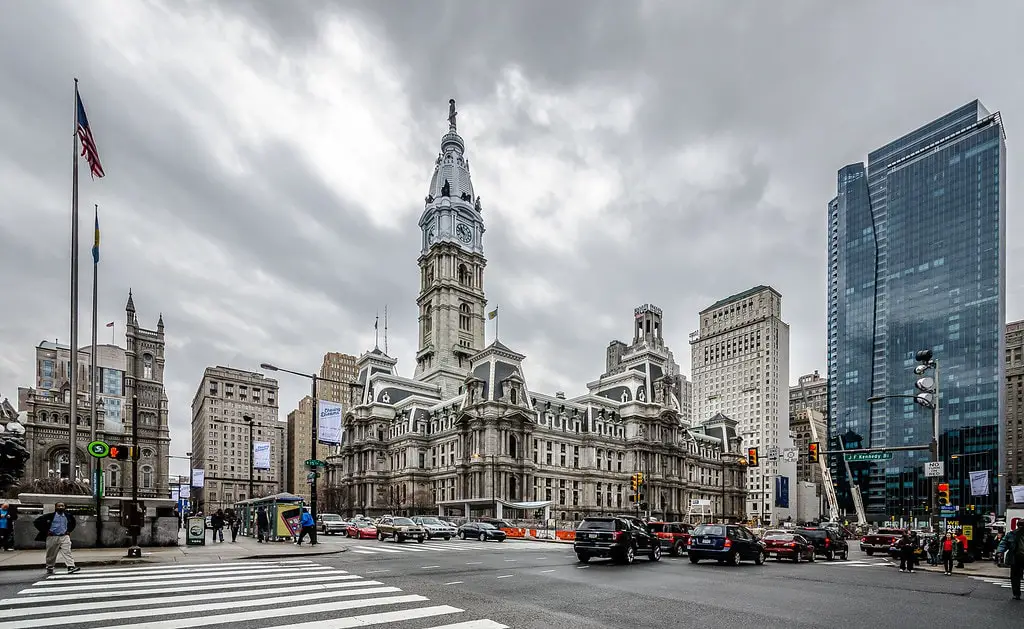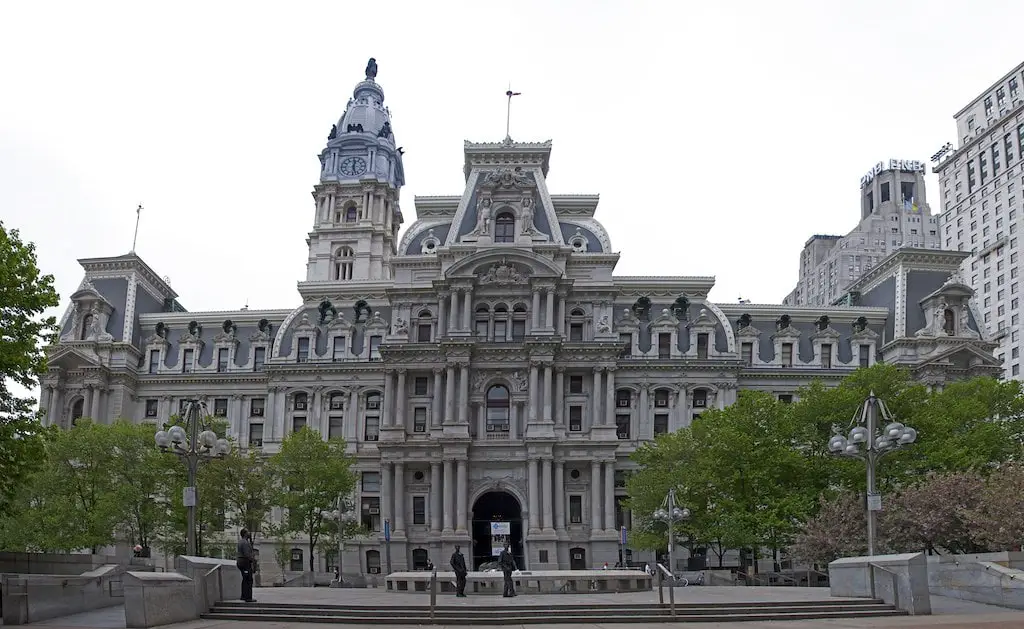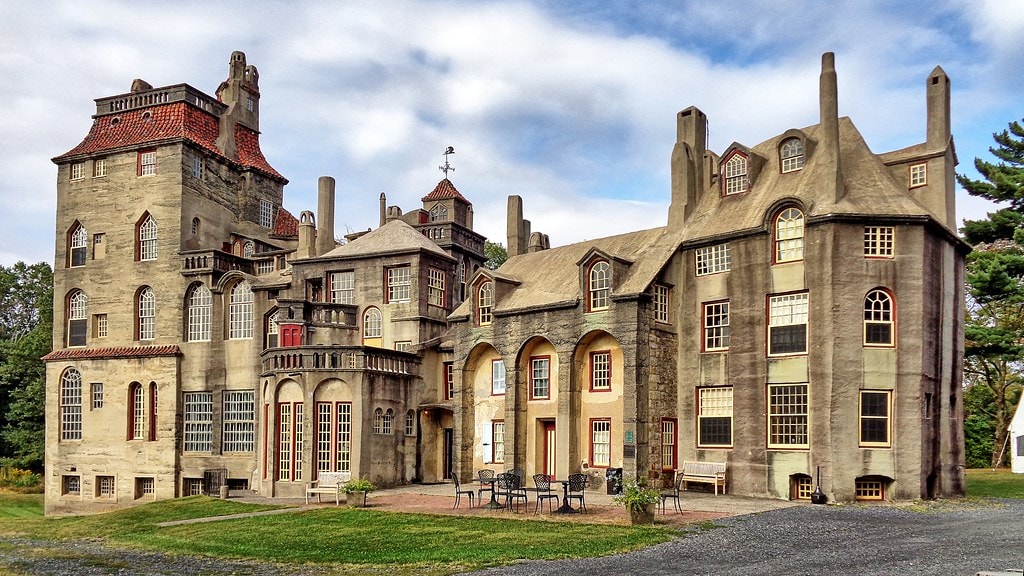Philadelphia City Hall - Historical Marvel
In the heart of Philadelphia lies a grand testament to American history and architectural prowess - the iconic Philadelphia City Hall. Once the tallest habitable building in the world, this magnificent structure boasts the world's largest free-standing masonry construction.
With over 700 rooms, it is the largest municipal building in the United States. It houses the city's executive, legislative, and judicial branches.
Philadelphia City Hall, designed by Scottish-born architects John McArthur Jr. and Thomas Ustick Walter, was constructed between 1871 and 1901 for $24 million.
The building's distinctive Second Empire style is complemented by the work of stonemason William Struthers and sculptor Alexander Milne Calder, who together created over 250 sculptures adorning the building.
The structure was designated a National Historic Landmark in 1976, and the American Society of Civil Engineers named it a National Historic Civil Engineering Landmark in 2006.
Towering Above
Philadelphia City Hall's crowning glory is its magnificent clock tower, which stands 548 ft (167 m) high and includes the statue of city founder William Penn atop it.
Completed in 1894, the tower was the tallest habitable building in the world until 1908 and remained the most elevated in Pennsylvania until it was surpassed by Pittsburgh's Gulf Tower in 1932.
The tower features a clock face on each side, each with a diameter of 26 ft (7.9 m). The clock, designed by Warren Johnson and built in 1898, has a unique custom: every evening at three minutes to nine, the tower lights are turned off and then turned on again on the hour, allowing observers to set their timepieces.
William Penn's Watchful Eye
Perched atop the tower is a 37-ft (11-m) bronze statue of William Penn, weighing 53,348 lb (24,198 kg). Created by Alexander Milne Calder, this statue is the tallest atop any building in the world.
Despite its lofty position, the city requires regular cleaning to prevent corrosion and weather-related deterioration.
Interestingly, Calder intended for the statue to face south and be better illuminated by the sun. Instead, the statue faces northeast towards Penn Treaty Park, commemorating the site where Penn signed a treaty with a local Native American tribe.

A Gentleman's Agreement
For decades, an informal agreement prevented any building in Philadelphia from rising higher than the statue of William Penn.
This agreement was finally broken in 1986 when One Liberty Place was constructed, surpassing City Hall's height.
Some say this act brought a curse upon the city's professional sports teams, which was only lifted when the Phillies won the 2008 World Series.
Centre Square: The Heart of the City
Philadelphia City Hall is situated on land that was once known as Centre Square, one of the five original squares laid out by William Penn in his city grid.
While the square is no longer at the city's geographical center, it remains a crucial part of Philadelphia's historic district, now known as Center City.
Penn intended Centre Square to be the city's focal point, where significant public buildings, markets, and gathering spaces would be located.
Today, the legacy of Penn's vision endures, with City Hall standing as a proud testament to the city's rich history and architectural achievements.

A Cinematic Landmark
Philadelphia City Hall's impressive architecture and iconic status have made it a popular filming location. The building's majestic exterior, ornate interior, and historical significance have attracted filmmakers looking for a visually stunning and versatile backdrop.
- "Rocky" (1976): The iconic scene where Rocky Balboa runs up the Philadelphia Museum of Art steps also features City Hall in the background.
- "Blow Out" (1981): This thriller, directed by Brian De Palma, showcases City Hall's exterior and surrounding areas.
- "Trading Places" (1983): This classic comedy starring Eddie Murphy and Dan Aykroyd includes scenes filmed at City Hall.
- "Philadelphia" (1993): The Academy Award-winning drama featuring Tom Hanks and Denzel Washington highlights City Hall as a symbol of the city and its legal system.
- "12 Monkeys" (1995): This science fiction film, starring Bruce Willis and Brad Pitt, features City Hall as a key location in a dystopian future.
- "National Treasure" (2004): The adventure film starring Nicolas Cage includes scenes at City Hall and its vicinity.
- "Transformers: Revenge of the Fallen" (2009): The blockbuster sequel showcases City Hall during an action-packed sequence.
- "Limitless" (2011): The thriller starring Bradley Cooper features City Hall as a backdrop for several scenes.
Philadelphia City Hall's appearances in these films have helped solidify its status as a beloved city landmark and a symbol of its rich history and culture.
A Towering Achievement: Philadelphia City Hall's Clock and Observation Deck
A Historic Clock Tower
City Hall's clock tower is an engineering marvel that has stood the test of time. When completed, it was the tallest clock tower in the world.
Although surpassed by the Metropolitan Life Insurance Company Tower in 1912, it remains the fifth tallest clock tower globally.
- Clock faces: Each of the tower's four sides features a clock face 26 ft (7.9 m) in diameter, larger than Big Ben's 23 ft (7 m) clock faces.
- Custom design: The clock was designed by Warren Johnson and built in 1898.
- Evening tradition: Since its installation, the tower lights have been turned off every evening from three minutes to nine and turned on again at the hour, allowing observers to set their timepieces even if they cannot see the clock hands.
- Bronze eagles: Above each of the tower's clocks is a three-ton bronze eagle with a 12 ft (3.7 m) wingspan.

Observation Deck with a View
City Hall's observation deck, located directly below the base of the William Penn statue, offers visitors breathtaking panoramic views of Philadelphia from approximately 500 ft (150 m) above street level.
- Enclosed by the glass: Originally enclosed with chain-link fencing, the observation deck is now surrounded by glass for enhanced visibility and safety.
- Elevator access: Visitors can reach the observation deck via a six-person elevator. The elevator's glass panels reveal the iron superstructure supporting the tower's statuary and clocks.
- Stair access: Stairs within the tower are available for emergency exits only.
A Legacy in Stone: The Sculptures of Philadelphia City Hall
Alexander Milne Calder's Masterpieces
City Hall has over 250 sculptures, most created by renowned sculptor Alexander Milne Calder. These sculptures capture American ideals and pay homage to artists, educators, and engineers who have contributed to the nation's development.
- William Penn statue: The most iconic of these sculptures is a bronze statue of city founder William Penn. Casted in 1894 and atop the tower, it is the tallest statue on any building in the world.
- Regular cleaning: Despite its height, the city mandates that the statue be cleaned approximately every ten years to remove corrosion and reduce weathering-related deterioration.
Sculptures Inside and Out
In addition to the William Penn statue, Calder's sculptures grace both the interior and exterior of City Hall. They serve as a testament to the building's architectural and artistic legacy.
- Exterior sculptures: Many of Calder's sculptures can be found on the building's facade, including figures representing various historical figures and symbolic representations of virtues and ideals.
- Interior sculptures: The building's interior also features numerous sculptures, some of which are incorporated into the design of staircases, walls, and doorways.

Conclusion
Philadelphia City Hall is a remarkable testament to the city's rich history, architectural prowess, and artistic excellence.
City Hall's many facets continue to enchant residents and visitors alike, from its elaborate French Second Empire style to its prominent position in American film.
City Hall's clock tower, observation deck, and countless sculptures adorning its exterior and interior are enduring reminders of the creativity and craftsmanship that went into its construction.
As a vital part of Philadelphia's cultural fabric, it remains a must-see destination for anyone interested in exploring the City of Brotherly Love.









